Variable Urbanization Warming Effects across Metropolitans of China and Relevant Driving Factors
Abstract
1. Introduction
2. Study Regions and Datasets
2.1. The Study Regions
2.2. Remote Sensing Data
2.2.1. Landsat 8 OLI/TIRS Remote Sensing Data
2.2.2. Land Surface Temperature (LST) Data
2.2.3. Data Sets for Identification of Influencing Factors
- (1)
- Vegetation indices, albedo, and climatic variables are the driving factors behind global UHI [15]. These driving factors were analyzed using the following datasets:
- (2)
- The 16–day synthetic data of MODIS Normalized Difference Vegetation Index (NDVI) (MOD13A1) with a resolution of 500m×500m during 2015 (https://search.earthdata.nasa.gov/). The data is subject to pre–processing such as projection conversion, image stitching and image cropping, and the resolution of the NDVI data was resampled to keep consistent with the resolution of the LST data.
- (3)
- The MODIS Albedo Data (MCD43A3) during 2015 by the Daily Bidirectional Reflectance Distribution Function (BRDF) with a resolution of 500 m × 500 m (https://search.earthdata.nasa.gov/). The MODIS albedo dataset includes short-wavelength (0.3 0.5 μm) black-space albedo and white-space albedo. Since these two albedo wavelengths have similar linear relationships with surface UHI, only short-wavelength black-space albedo was considered in this current study [12,15].
- (4)
- Temperature and precipitation data. Temperature data were extracted from the ERA-interim 2-m temperature monthly reanalysis data during 2015, with a spatial resolution of 0.125°×0.125°(https://www.ecmwf.int/). The data were produced by four-dimensional variational assimilation technology by the European Centre for Medium Weather (European Centre for Medium–Range Weather Forecasts, ECMWF). It is the third generation of the reanalysis data from the European Weather Forecast Center [53]. The precipitation data were sourced from the tropical rainfall measurement mission satellite TRMM 3B42RT, with a spatial resolution of 0.25° × 0.25°. The daily precipitation during 2015 were from the NASA website (https://mirador.gsfc.nasa.gov/). Moreover, the temperature data and the TRMM data were resampled to 1 km and ensured that the resolution is consistent with the resolution of the LST data.
- (5)
- Global Digital Elevation Model (DEM). China’s DEM data were by the Shuttle Radar Topography Mission (SRTM) system of the US Space Shuttle Endeavour. The data were from the Resource and Environmental Science Data Center of the Chinese Academy of Sciences (www. Resdc.cn), with a resolution of 90m × 90m. The resolution of the DEM data was resampled to 1000 m × 1000 m.
3. Methods
3.1. Extraction of the IS
3.2. Computation of the IS Density
3.3. Statistical Analysis
3.3.1. Pearson Correlation Analysis
3.3.2. Piecewise Linear Regression
3.3.3. Identification of Driving Factors behind UHI
4. Results
4.1. Spatiotemporal Pattern of the IS
4.2. Spatial Pattern of the LST
4.3. Relationship Between IS and LST Across the BTH.
4.4. Relationship Between IS and LST Across the YRD
4.5. Relationship Between is and LST Across the PRD
4.6. Relationship between other Factors than IS Density on LST Changes
5. Discussions
5.1. Accuracy of MODIS LST Data
5.2. Time-Scale Differences in the Effects of IS on LST
5.3. Spatial-Scale Differences in the Effects of IS on LST
6. Conclusions
- (1)
- In terms of temporal scale, the warming effect of IS on LST generally stronger in daytime than in nighttime and significantly stronger in summer than winter.
- (2)
- From the perspective of spatial scale, as for the individual city, the IS density has high impacts, indicating that IS can better reflect the change of LST at the individual city scale. Within the urban agglomerations, IS density has less significant impacts on LST, comparing to individual city. This is because larger spatial size includes more complicated underlying components and spatial structures, leading to the relative weakening of the IS–LST relations.
- (3)
- The differences in spatial sizes, latitude locations, and climate background over the three urban agglomerations in this study, resulting the differences in IS–LST relations between urban agglomerations. Linear relations cannot well describe the IS–LST relations in the BTH, with IS density appearing in segments between about 10% to 17%. This phenomenon indicates the IS density reaches a certain level, the impact on the thermal environment will be further reduced. Moreover, because of the different spatial sizes and climatic backgrounds of the three urban agglomerations, we observed that urban agglomerations are distributed from north to south in China, and the warming effect of IS on LST has gradually increased.
- (4)
- The relationships between IS and LST vary in both spatial and temporal scales, which indicates that LST is not only affected by IS density, but also affected by other driving factors such as precipitation, DEM, vegetation coverage, albedo, and temperature. Based on quantification of the driving factors behind LST, we found that the contribution rate of vegetation to LST was generally higher, followed by albedo. The heat exchange between the atmosphere and the surface will affect the change of LST, so the air temperature has a certain degree of positive driving on LST. The contribution of precipitation to LST is the lowest in this study area, and the impact of DEM on LST is slightly higher than precipitation.
Author Contributions
Funding
Acknowledgments
Conflicts of Interest
References
- Zhou, X.F.; Chen, H. Impact of urbanization-related land use land cover changes and urban morphology changes on the urban heat island phenomenon. Sci. Total Environ. 2018, 635, 1467–1476. [Google Scholar] [CrossRef] [PubMed]
- Du, H.Y.; Wang, D.D.; Wang, Y.Y.; Zhao, X.L.; Qin, F.; Jiang, H.; Cai, Y.L. Influences of land cover types, meteorological conditions, anthropogenic heat and urban area on surface urban heat island in the Yangtze River Delta Urban Agglomeration. Sci. Total Environ. 2016, 571, 461–470. [Google Scholar] [CrossRef] [PubMed]
- Zhao, L.; Lee, X.H.; Smith, R.B.; Oleson, K. Strong contributions of local background climate to urban heat islands. Nature. 2014, 511, 216–219. [Google Scholar] [CrossRef] [PubMed]
- Owen, T.W.; Carlson, T.N.; Gillies, R.R. An assessment of satellite remotely-sensed land cover parameters in quantitatively describing the climatic effect of urbanization. Int. J. Remote Sens. 1998, 19, 1663–1681. [Google Scholar] [CrossRef]
- Yuan, F.; Bauer, M.E. Comparison of impervious surface area and normalized difference vegetation index as indicators of surface urban heat island effects in Landsat imagery. Remote Sens. Environ. 2007, 106, 375–386. [Google Scholar] [CrossRef]
- Kalnay, E.; Cai, M. Impact of urbanization and land-use change on climate. Nature 2003, 423, 528–531. [Google Scholar] [CrossRef] [PubMed]
- Zhou, L.; Dickinson, R.E.; Tian, Y.; Fang, J.; Li, Q.; Kaufmann, R.K.; Tucker, C.J.; Myneni, R.B. Evidence for a significant urbanization effect on climate in china. Proc. Natl. Acad. Sci. USA 2004, 101, 9540–9544. [Google Scholar] [CrossRef]
- United Nations. Department of Economic and Social Affairs, Population Division, World Population Prospects: The 2010 Revision, Volume I: Comprehensive Tables. 2011. Available online: https://www.un.org/en/development/desa/publications/world-population-prospects-the-2010-revision.html (accessed on 3 May 2020).
- Zhu, X.D.; Zhang, Q.; Sun, P.; Singh, V.P.; Shi, P.J.; Song, C.Q. Impact of urbanization on hourly precipitation in Beijing, China: Spatiotemporal patterns and causes. Glob. Planet. Change 2019, 172, 307–324. [Google Scholar] [CrossRef]
- Reid, W.V. Biodiversity hotspots. Trends Ecol. Evol. 1998, 13, 275–280. [Google Scholar] [CrossRef]
- Gong, P.; Liang, S.; Carlton, E.J.; Jiang, Q.; Wu, J.; Wang, L.; Remais, J.V. Urbanization and health in China. Lancet 2012, 379, 843–852. [Google Scholar] [CrossRef]
- Zhou, D.C.; Zhao, S.Q.; Liu, S.G.; Zhang, L.X.; Zhu, C. Surface urban heat island in China’s 32 major cities: Spatial patterns and drivers. Remote Sens. Environ. 2014, 152, 51–61. [Google Scholar] [CrossRef]
- Yang, J.C.; Hu, L.Q.; Wang, C.H. Population dynamics modify urban residents’ exposure to extreme temperatures across the United States. Sci. Adv. 2019, 5, eaay3452. [Google Scholar] [CrossRef] [PubMed]
- Estoque, R.C.; Murayama, Y.; Myint, S.W. Effects of landscape composition and pattern on land surface temperature: An urban heat island study in the megacities of Southeast Asia. Sci. Total Environ. 2017, 577, 349–359. [Google Scholar] [CrossRef] [PubMed]
- Peng, S.S.; Piao, S.L.; Ciais, P.; Friedlingstein, P.; Ottle, C.; Bréon, F.M.; Nan, H.J.; Zhou, L.M.; Myneni, R.B. Surface urban heat island across 419 global big cities. Environ. Sci. Technol. 2012, 46, 696–703. [Google Scholar] [CrossRef]
- Chow, W.T.L.; Roth, M. Temporal dynamics of the urban heat island of Singapore. Int. J. Climatol. 2006, 26, 2243–2260. [Google Scholar] [CrossRef]
- Azevedo, J.A.; Chapman, L.; Muller, C.L. Quantifying the daytime and night-time urban heat island in Birmingham, UK: A comparison of satellite derived land surface temperature and high resolution air temperature observations. Remote Sens. 2016, 8, 153. [Google Scholar] [CrossRef]
- Li, H.D.; Zhou, Y.Y.; Li, X.M.; Meng, L.; Wang, X.; Wu, S.; Sodoudi, S. A new method to quantify surface urban heat island intensity. Sci. Total Environ. 2018, 624, 262–272. [Google Scholar] [CrossRef]
- Myint, S.W.; Wentz, E.A.; Brazel, A.J.; Quattrochi, D.A. The impact of distinct anthropogenic and vegetation features on urban warming. Landsc. Ecol. 2013, 28, 959–978. [Google Scholar] [CrossRef]
- Kourtidis, K.; Georgoulias, A.K.; Rapsomanikis, S.; Amiridis, V.; Keramitsoglou, I.; Hooyberghs, H.; Melas, D. A study of the hourly variability of the urban heat island effect in the Greater Athens Area during summer. Sci. Total Environ. 2015, 517, 162–177. [Google Scholar] [CrossRef]
- Tran, D.X.; Pla, F.; Latorre-Carmona, P.; Myint, S.W.; Caetano, M.; Kieu, H.V. Characterizing the relationship between land use land cover change and land surface temperature. ISPRS J. Photogramm. Remote Sens. 2017, 124, 119–132. [Google Scholar] [CrossRef]
- Majkowska, A.; Kolendowicz, L.; Półrolniczak, M.; Hauke, J.; Czernecki, B. The urban heat island in the city of Poznań as derived from Landsat 5 TM. Theor. Appl. Climatol. 2016, 128, 1–15. [Google Scholar] [CrossRef]
- Imhoff, M.L.; Zhang, P.; Wolfe, R.E.; Bounoua, L. Remote sensing of the urban heat island, effect across biomes in the continental USA. Remote Sens. Environ. 2010, 114, 504–513. [Google Scholar] [CrossRef]
- Song, J.; Du, S.H.; Feng, X.; Guo, L. The relationships between landscape compositions and land surface temperature: Quantifying their resolution sensitivity with spatial regression models. Landsc. Urban Plan. 2014, 123, 145–157. [Google Scholar] [CrossRef]
- Cheval, S.; Dumitrescu, A. The summer surface urban heat island of Bucharest (Romania) retrieved from MODIS images. Theor. Appl. Climatol. 2015, 121, 631–640. [Google Scholar] [CrossRef]
- Arnold, C.L.; Gibbons, C.J. Impervious surface coverage: The emergence of a key environmental indicator. J. Am. Plan. Assoc. 1996, 62, 243–258. [Google Scholar] [CrossRef]
- Weng, Q.H. Remote sensing of impervious surfaces in the urban areas: Requirements, methods, and trends. Remote Sens. Environ. 2012, 117, 34–49. [Google Scholar] [CrossRef]
- Arnfield, A.J. Two decades of urban climate research: A review of turbulence, exchanges of energy and water, and the urban heat island. Int. J. Climatol. 2003, 23, 1–26. [Google Scholar] [CrossRef]
- Oke, T.R. The energetic basis of the urban heat island. Q. J. R. Meteorol. Soc. 1982, 108, 1–24. [Google Scholar] [CrossRef]
- Meng, Q.Y.; Zhang, L.L.; Sun, Z.H.; Meng, F.; Wang, L.; Sun, Y.X. Characterizing spatial and temporal trends of surface urban heat island effect in an urban main built-up area: A 12-year case study in Beijing, China. Remote Sens. Environ. 2017, 204, 826–837. [Google Scholar] [CrossRef]
- Rhee, J.Y.; Park, S.Y.; Lu, Z.Y. Relationship between land cover patterns and surface temperature in urban areas. GISci. Remote Sens. 2014, 51, 521–536. [Google Scholar] [CrossRef]
- Morabito, M.; Crisci, A.; Messeri, A.; Orlandini, S.; Raschi, A.; Maracchi, G.; Munafo, M. The impact of built-up surfaces on land surface temperatures in Italian urban areas. Sci. Total Environ. 2016, 551, 317–326. [Google Scholar] [CrossRef] [PubMed]
- Sun, Q.Q.; Wu, Z.F.; Tan, J.J. The relationship between land surface temperature and land use/land cover in Guangzhou, China. Environ. Earth Sci. 2012, 65, 1687–1694. [Google Scholar] [CrossRef]
- Xu, H.Q.; Lin, D.F.; Tang, F. The impact of impervious surface development on land surface temperature in a subtropical city: Xiamen, China. Int. J. Climatol. 2013, 33, 1873–1883. [Google Scholar] [CrossRef]
- Ding, H.Y.; Shi, W.Z. Land-use/land-cover change and its influence on surface temperature: A case study in Beijing City. Int. J. Remote Sens. 2013, 34, 5503–5517. [Google Scholar] [CrossRef]
- Guo, G.H.; Wu, Z.F.; Xiao, R.B.; Chen, Y.B.; Liu, X.N.; Zhang, X.S. Impacts of urban biophysical composition on land surface temperature in urban heat island clusters. Landsc. Urban Plan. 2015, 135, 1–10. [Google Scholar] [CrossRef]
- Kuang, W.H.; Liu, Y.; Dou, Y.Y.; Chi, W.F.; Chen, G.S.; Gao, C.F.; Yang, T.R.; Liu, J.Y.; Zhang, R.H. What are hot and what are not in an urban landscape: Quantifying and explaining the land surface temperature pattern in Beijing, China. Landsc. Ecol. 2015, 30, 357–373. [Google Scholar] [CrossRef]
- Guo, L.J.; Liu, R.M.; Men, C.; Wang, Q.R.; Miao, Y.X.; Zhang, Y. Quantifying and simulating landscape composition and pattern impacts on land surface temperature: A decadal study of the rapidly urbanizing city of Beijing, China. Sci. Total Environ. 2019, 654, 430–440. [Google Scholar] [CrossRef]
- Xie, H.L.; He, Y.F.; Xie, X. Exploring the factors influencing ecological land change for China’s Beijing-Tianjin-Hebei Region using big data. J. Clean Prod. 2017, 142, 667–687. [Google Scholar] [CrossRef]
- Shi, Y.; Jiang, Z.H.; Dong, L.P.; Shen, S.H. Statistical Estimation of High-Resolution Surface Air Temperature from MODIS over the Yangtze River Delta, China. J. Meteorol. Res. 2017, 2, 190–196. [Google Scholar] [CrossRef]
- Hu, D.K.; Clift, P.D.; Boning, P.; Hannigan, R.; Hillier, S.; Blusztajn, J.; Wan, S.M.; Fuller, D.Q. Holocene evolution in weathering and erosion patterns in the Pearl River delta. Geochem. Geophys. Geosyst. 2013, 14, 2349–2368. [Google Scholar] [CrossRef]
- Xiao, J.C.; Yuan, Z. The Top Ten Urban Agglomerations in China; Economic Science Press: Beijing, China, 2009; pp. 363–367. [Google Scholar]
- Shao, Y.H.; Wu, J.M.; Ye, J.Y.; Liu, Y.H. Frequency analysis and its spatiotemporal characteristics of precipitation extreme events in China during 1951-2010. Theor. Appl. Climatol. 2015, 121, 1–13. [Google Scholar] [CrossRef]
- Wang, J.; Zhou, W.Q.; Xu, K.P.; Yan, J.L. Spatiotemporal pattern of vegetation cover and its relationship with urbanization in Beijing-Tianjin-Hebei megaregion from 2000 to 2010. Acta Ecol. Sinica 2017, 37, 7019–7029. [Google Scholar]
- Jia, Y.Q.; Zhang, B.; Zhang, Y.Z.; Tang, M.; Ma, B.; Wang, G.Q.; Liu, X.L.; Luo, Z.M. Effect of urbanization on spatial and temporal variation of extreme temperature events in the Yangtze River Delta. J. Nat. Resour. 2017, 32, 814–828. [Google Scholar]
- Li, R.J. Discussion on the gains and losses of urbanization in the Pearl River Delta—Analysis based on the census data. Popul. Econ. 2014, 1, 15–18. [Google Scholar]
- Xu, H.Q.; Wang, M.H. Remote sensing-based retrieval of ground impervious surfaces. J. Remoting Sens. 2016, 20, 1993–2002. [Google Scholar]
- Madhavan, B.B.; Kubo, S.; Kurisaki, N.; Sivakumar, T.V.L.N. Appraising the anatomy and spatial growth of the bangkok metropolitan area using a vegetation-impervious-soil model through remote sensing. Int. J. Remote Sens. 2001, 22, 789–806. [Google Scholar] [CrossRef]
- Wan, Z.M.; Dozier, J. A generalized split-window algorithm for retrieving land-surface temperature from space. IEEE Trans. Geosci. Remote Sens. 1996, 34, 892–905. [Google Scholar]
- Rigo, G.; Parlow, E.; Oesch, D. Validation of satellite observed thermal emission with in-situ measurements over an urban surface. Remote Sens. Environ. 2006, 104, 201–210. [Google Scholar] [CrossRef]
- Wang, K.C.; Wang, J.K.; Wang, P.C.; Sparrow, M.; Yang, J.; Chen, H.B. Influences of urbanization on surface characteristics as derived from the Moderate-Resolution Imaging Spectroradiometer: A case study for the Beijing metropolitan area. J. Geophys. Res. Atmos. 2007. [Google Scholar] [CrossRef]
- Wan, Z. New refinements and validation of the MODIS Land Surface Temperature/Emissivity products. Remote Sens. Environ. 2008, 112, 59–74. [Google Scholar] [CrossRef]
- Dee, D.P.; Uppala, S.M.; Simmons, A.J. The ERA-Interim reanalysis: Configuration and performance of the data assimilation system. Q. J. R. Meteorol. Soc. 2011, 137, 553–597. [Google Scholar] [CrossRef]
- Estoque, R.C.; Murayama, Y. Classification and change detection of built-up lands from landsat-7 ETM+ and landsat-8 OLI/TIRS imageries: A comparative assessment of various spectral indices. Ecol. Indic. 2015, 56, 205–217. [Google Scholar] [CrossRef]
- Xu, H.Q. Modification of normalised difference water index (NDWI) to enhance open water features in remotely sensed imagery. Int. J. Remote Sens. 2006, 27, 3025–3033. [Google Scholar] [CrossRef]
- Justice, C.O.; Vermote, E.; Townshend, J.R.; Defries, R.; Roy, D.P.; Hall, D.K.; Salomonson, V.V.; Privette, J.L.; Riggs, G.; Strahler, A. The moderate resolution imaging spectroradiometer (MODIS): Land remote sensing for global change research. IEEE Trans. Geosci. Remote Sens. 1998, 36, 1228–1249. [Google Scholar] [CrossRef]
- Pearson, K. Note on regression and inheritance in the case of two parents. Proc. R. Soc. Lond. 1985, 58, 240–242. [Google Scholar]
- Ma, Q.; Wu, J.G.; He, C.Y. A hierarchical analysis of the relationship between urban impervious surfaces and land surface temperatures: Spatial scale dependence, temporal variations, and bioclimatic modulation. Landsc. Ecol. 2016, 31, 1139–1153. [Google Scholar] [CrossRef]
- Pan, N.Q.; Feng, X.M.; Fu, B.J.; Wang, S.; Ji, W.; Pan, S.F. Increasing global vegetation browning hidden in overall vegetation greening: Insights from time-varying trends. Remote Sens. Environ. 2018, 214, 59–72. [Google Scholar] [CrossRef]
- Muggeo, V.M.R. Interval estimation for the breakpoint in segmented regression: A smoothed score-based approach. Aust. N. Z. J. Stat. 2017, 59, 311–322. [Google Scholar] [CrossRef]
- Liu, Y.X.; Peng, J.; Wang, Y.L. Efficiency of landscape metrics characterizing urban land surface temperature. Landsc. Urban Plan. 2018, 180, 36–53. [Google Scholar] [CrossRef]
- Hocking, R.R. A biometrics invited paper. the analysis and selection of variables in linear regression. Biometrics 1976, 32, 1–49. [Google Scholar] [CrossRef]
- Sakamoto, Y.; Ishiguro, M.; Kitagawa, G. Akaike Information Criterion Statistics; D. Reidel: Dordrecht, The Netherlands, 1986. [Google Scholar]
- Tao, S.L.; Fang, J.Y.; Zhao, X.; Shen, H.H.; Hu, H.F.; Tang, Z.Y.; Wang, Z.H.; Guo, Q.H. Rapid loss of lakes on the Mongolian Plateau. Proc. Natl. Acad. Sci. USA 2015, 112, 2281–2286. [Google Scholar] [CrossRef] [PubMed]
- Nakagawa, S.; Schielzeth, H. A general and simple method for obtaining R2 from generalized linear mixed-effects models. Methods Ecol. Evol. 2013, 4, 133–142. [Google Scholar] [CrossRef]
- Zhang, Q.; Singh, V.P.; Peng, J.T.; Chen, Y.D.; Li, J.F. Spatial–temporal changes of precipitation structure across the Pearl River basin, China. J. Hydrol. 2012, 440, 113–122. [Google Scholar] [CrossRef]
- Clinton, N.; Gong, P. MODIS detected surface urban heat islands and sinks: Global locations and controls. Remote Sens. Environ. 2013, 134, 294–304. [Google Scholar] [CrossRef]
- Zhang, P.; Imhoff, M.L.; Bounoua, L.; Wolfe, R.E. Exploring the influence of impervious surface density and shape on urban heat islands in the northeast United States using MODIS and Landsat. Can. J. Remote Sens. 2012, 38, 441–451. [Google Scholar]
- Ravanelli, R.; Nascetti, A.; Cirigliano, R.; Rico, C.D.; Leuzzi, G.; Monti, P.; Crespi, M. Monitoring the Impact of Land Cover Change on Surface Urban Heat Island through Google Earth Engine: Proposal of a Global Methodology, First Applications and Problems. Remote Sens. 2018, 10, 1488. [Google Scholar] [CrossRef]
- Cui, Y.P.; Xu, X.L.; Dong, J.W.; Qin, Y.C. Influence of urbanization factors on surface urban heat island intensity: A comparison of countries at different developmental phases. Sustainability 2016, 8, 706. [Google Scholar] [CrossRef]
- Ma, Q.; Wu, J.G.; He, C.Y.; Hu, G.H. Spatial scaling of urban impervious surfaces across evolving landscapes: From cities to urban regions. Landsc. Urban Plan. 2018, 175, 50–61. [Google Scholar] [CrossRef]
- Buyantuyev, A.; Wu, J.G. Urban heat islands and landscape heterogeneity: Linking spatiotemporal variations in surface temperatures to land-cover and socioeconomic patterns. Landsc. Ecol. 2010, 25, 17–33. [Google Scholar] [CrossRef]
- Li, J.X.; Song, C.H.; Cao, L.; Zhu, F.G.; Meng, X.L.; Wu, J.G. Impacts of landscape structure on surface urban heat islands: A case study of shanghai, china. Remote Sens. Environ. 2011, 115, 3249–3263. [Google Scholar] [CrossRef]
- Bai, Y.; Wang, M.; Meng, H.; Huang, S.F.; Su, J.H.; Sha, C.Y.; Ruan, J.J. Relationship between land surface temperature and land cover in rapid urbanization process of Shanghai. Environ. Pollut. Control. 2013, 35, 49–54. [Google Scholar]
- Chi, T.L.; Zeng, J.; Liu, C. A study of evolution mechanism and diffusion mode pattern of thermal environment for Wuhan City in the past 30 years. Remote Sens. Land Resour. 2017, 29, 197–204. [Google Scholar]
- Wang, C.H.; Wang, Z.H.; Wang, C.Y.; Mytin, S.W. Environmental cooling provided by urban trees under extreme heat and cold waves in U.S. cities. Remote Sens. Environ. 2019, 227, 28–43. [Google Scholar] [CrossRef]
- Cherubini, F.; Huang, B.; Xu, X.P.; Tolle, M.H.; Strømman, A.H. Quantifying the climate response to extreme land cover changes in Europe with a regional model. Environ. Res. Lett. 2018. [CrossRef]
- Ho, H.C.; Knudby, A.; Sirovyak, P.; Xu, Y.; Hodul, M.; Henderson, S.B. Mapping maximum urban air temperature on hot summer days. Remote Sens. Environ. 2014, 154, 38–45. [Google Scholar] [CrossRef]
- Zhu, X.D.; Zhang, Q.; Xu, C.Y.; Sun, P.; Hu, P. Reconstruction of high spatial resolution surface air temperature data across China: A new geo-intelligent multisource data-based machine learning technique. Sci. Total Environ. 2019, 664, 300–313. [Google Scholar] [CrossRef]
- Zhang, T.; Barry, R.G.; Gilichinsky, D.; Bykhovets, S.S.; Sorokovikov, V.A.; Ye, J.P. An amplified signal of climatic change in soil temperatures during the last century at Irkutsk, Russia. Clim. Change 2001, 49, 41–76. [Google Scholar] [CrossRef]
- Wang, K.; Wan, Z.; Wang, P.; Sparrow, M.; Liu, J.; Haginoya, S. Evaluation and improvement of the MODIS land surface temperature/emissivity products using ground-based measurements at a semi-desert site on the western Tibetan Plateau. Int. J. Remote Sens. 2007, 28, 2549–2565. [Google Scholar] [CrossRef]
- Yu, W.P.; Ma, G.M. Validation of the MODIS land surface temperature products—A case study of the Heihe River Basin. Remote Sens. Technol. Appl. 2011, 26, 705–712. [Google Scholar]
- Wang, K.C.; Liang, S.L. Evaluation of ASTER and MODIS land surface temperature and emissivity products using long-term surface longwave radiation observations at SURFRAD sites. Remote Sens. Environ. 2009, 113, 1556–1565. [Google Scholar] [CrossRef]
- Wan, Z.M.; Zhang, Y.; Zhang, Q.; Li, Z.L. Quality assessment and validation of the MODIS global land surface temperature. Int. J. Remote Sens. 2004, 25, 261–274. [Google Scholar] [CrossRef]
- Chen, X.L.; Su, Z.B.; Ma, Y.M.; Cleverly, J.; Liddell, M. An Accurate Estimate of Monthly Mean Land Surface Temperatures from MODIS Clear-Sky Retrievals. J. Hydrometeorol. 2017, 18, 2827–2847. [Google Scholar] [CrossRef]
- Gao, M.F.; Qin, Z.H. The validation of Chinese land surface temperature products retrieved from Moderate Resolution Imaging Spectroradiometer data. Remote Sens. Land Resour. 2006, 3, 15–18. [Google Scholar]
- Liu, Y.; Li, H.; Gao, P.; Cheng, Z. Monitoring the detailed dynamics of regional thermal environment in a developing urban agglomeration. Sensors 2020, 20, 1197. [Google Scholar] [CrossRef]
- Wang, Y.Y.; Du, H.Y.; Xu, Y.Q.; Lu, D.B.; Wang, X.Y.; Guo, Z.Y. Temporal and spatial variation relationship and influence factors on surface urban heat island and ozone pollution in the Yangtze River Delta, China. Sci. Total Environ. 2018, 631, 921–933. [Google Scholar] [CrossRef]
- Ma, Y.L.; Yang, K.; Zhang, S.H.; Li, M.C. Impacts of Large-Area Impervious Surfaces on Regional Land Surface Temperature in the Great Pearl River Delta, China. J. Indian Soc. Remote Sens. 2019, 47, 1831–1845. [Google Scholar] [CrossRef]
- Xie, M.M.; Wang, Y.L.; Chang, Q.; Fu, M.C.; Ye, M.T. Assessment of landscape patterns affecting land surface temperature in different biophysical gradients in Shenzhen, China. Urban Ecosyst. 2013, 16, 871–886. [Google Scholar] [CrossRef]
- Kuang, W.H.; Yang, T.R.; Liu, A.L.; Zhang, C.; Lu, D.S.; Chi, W.F. An ecocity model for regulating urban land cover structure and thermal environment: Taking Beijing as an example. Sci. China Earth Sci. 2017, 60, 1098–1109. [Google Scholar] [CrossRef]
- Peng, J.; Ma, J.; Liu, Q.; Liu, Y.; Hu, Y.; Li, Y.; Yue, Y. Spatial-temporal change of land surface temperature across 285 cities in China: An urban-rural contrast perspective. Sci. Total Environ. 2018, 635, 487–497. [Google Scholar] [CrossRef]
- Zhou, B.; Rybski, D.; Kropp, J.P. On the statistics of urban heat island intensity. Geophys. Res. Lett. 2013, 40, 5486–5491. [Google Scholar] [CrossRef]
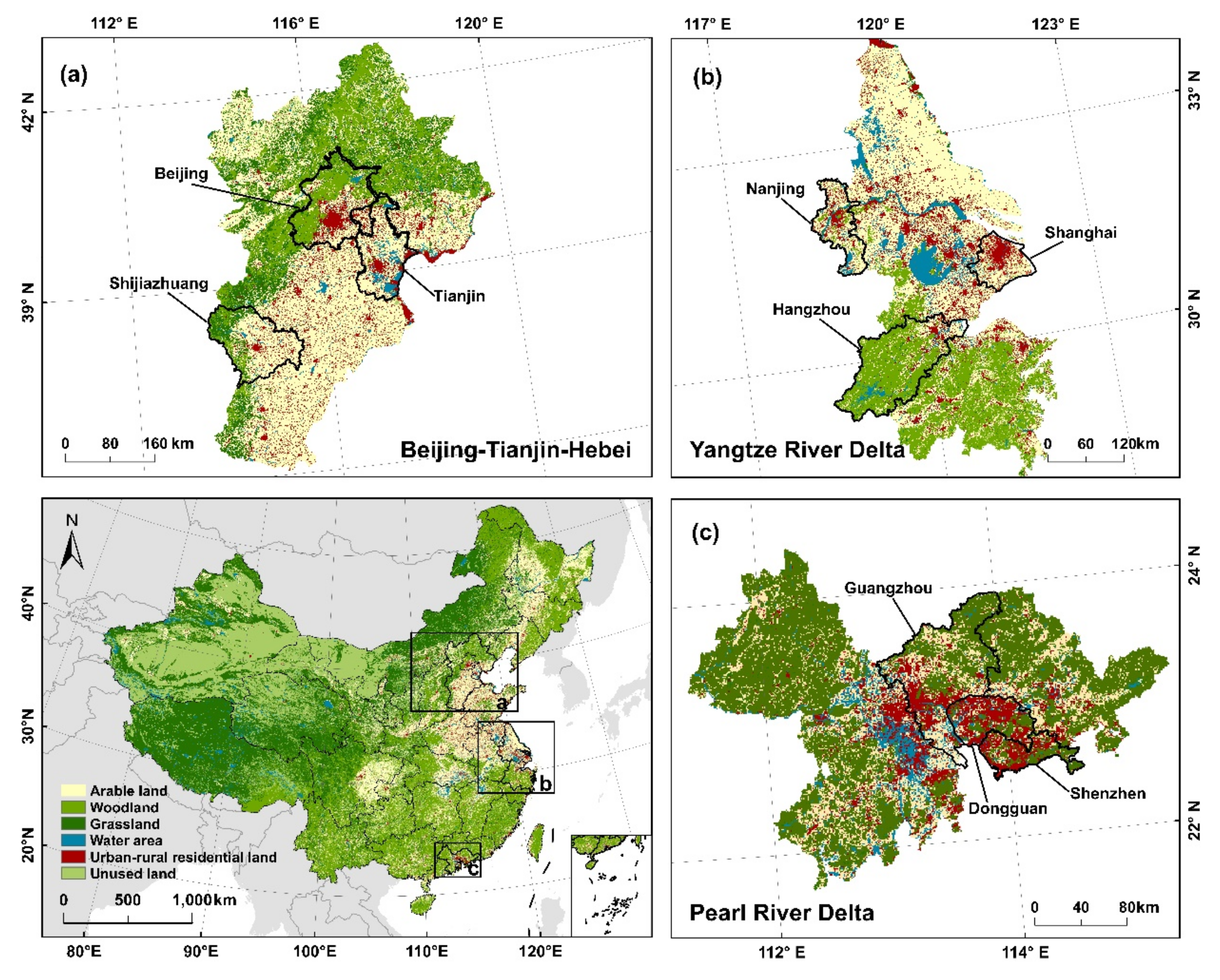
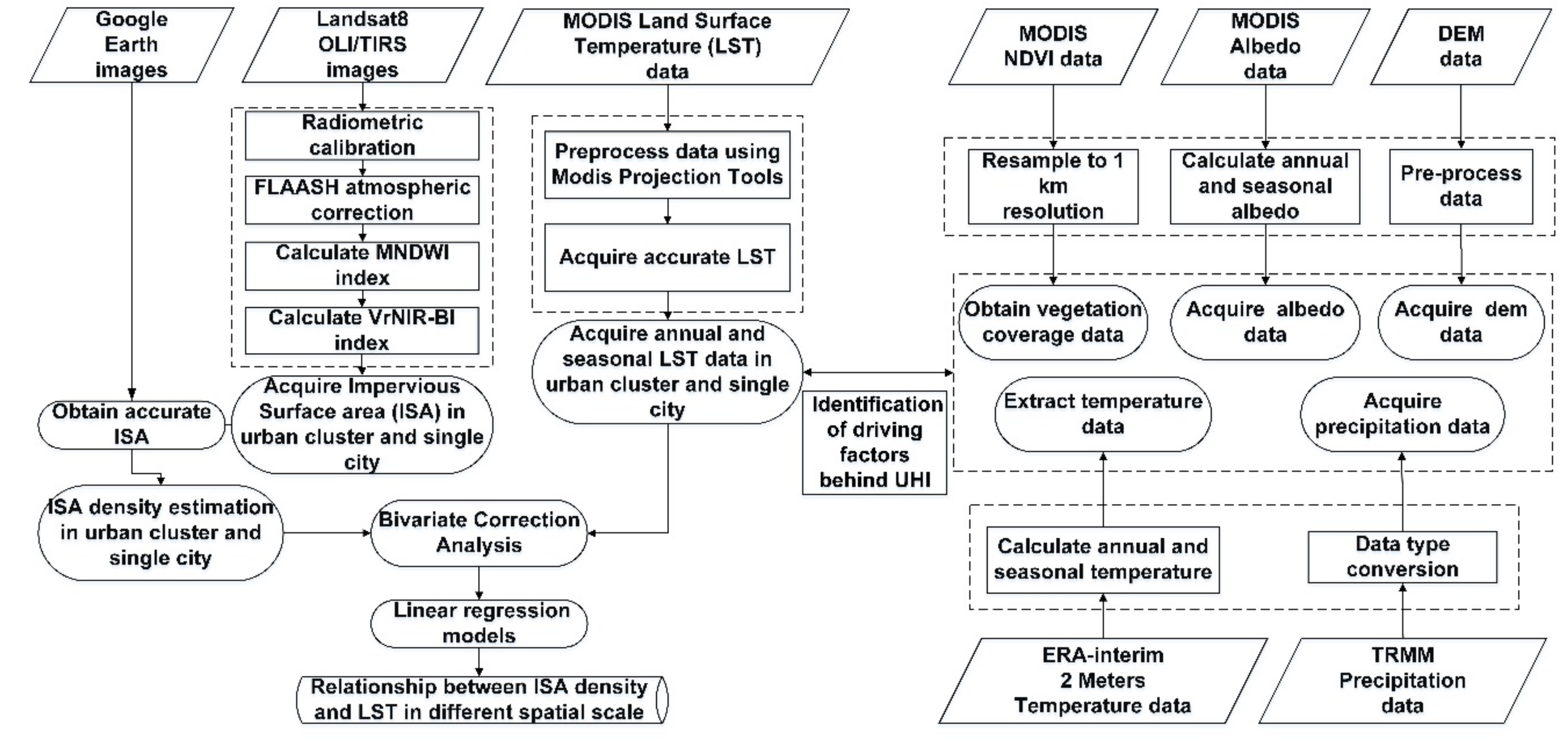

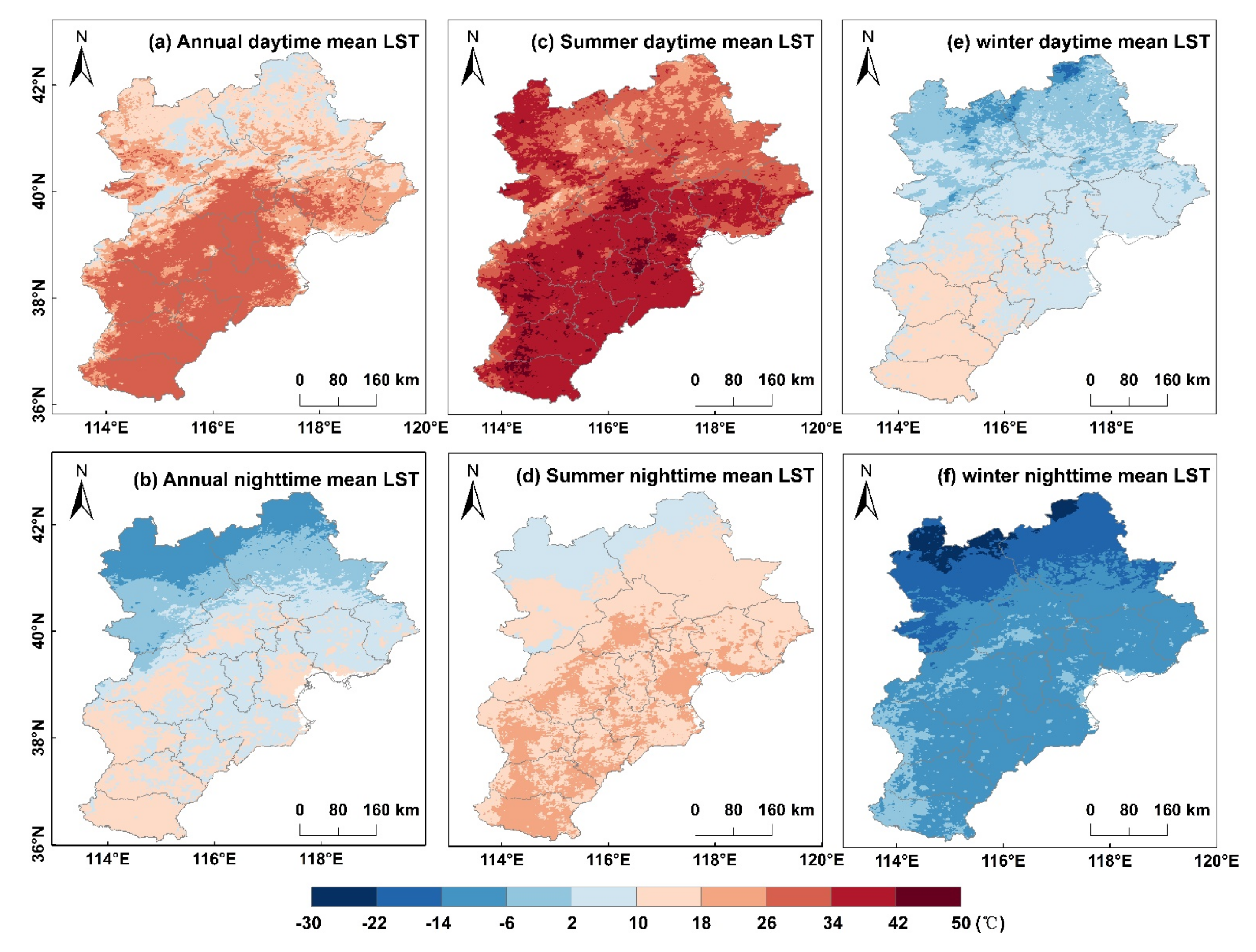
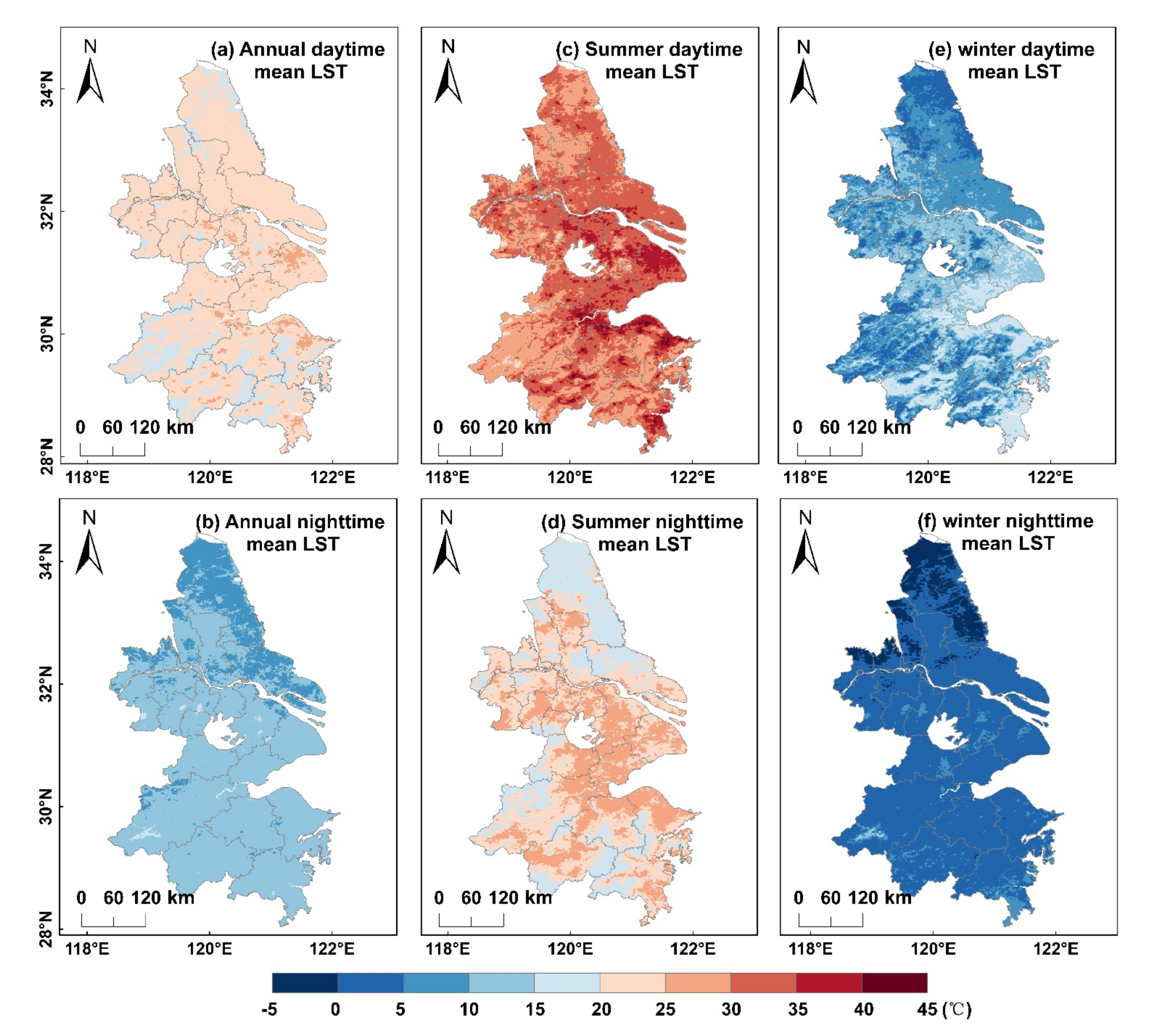
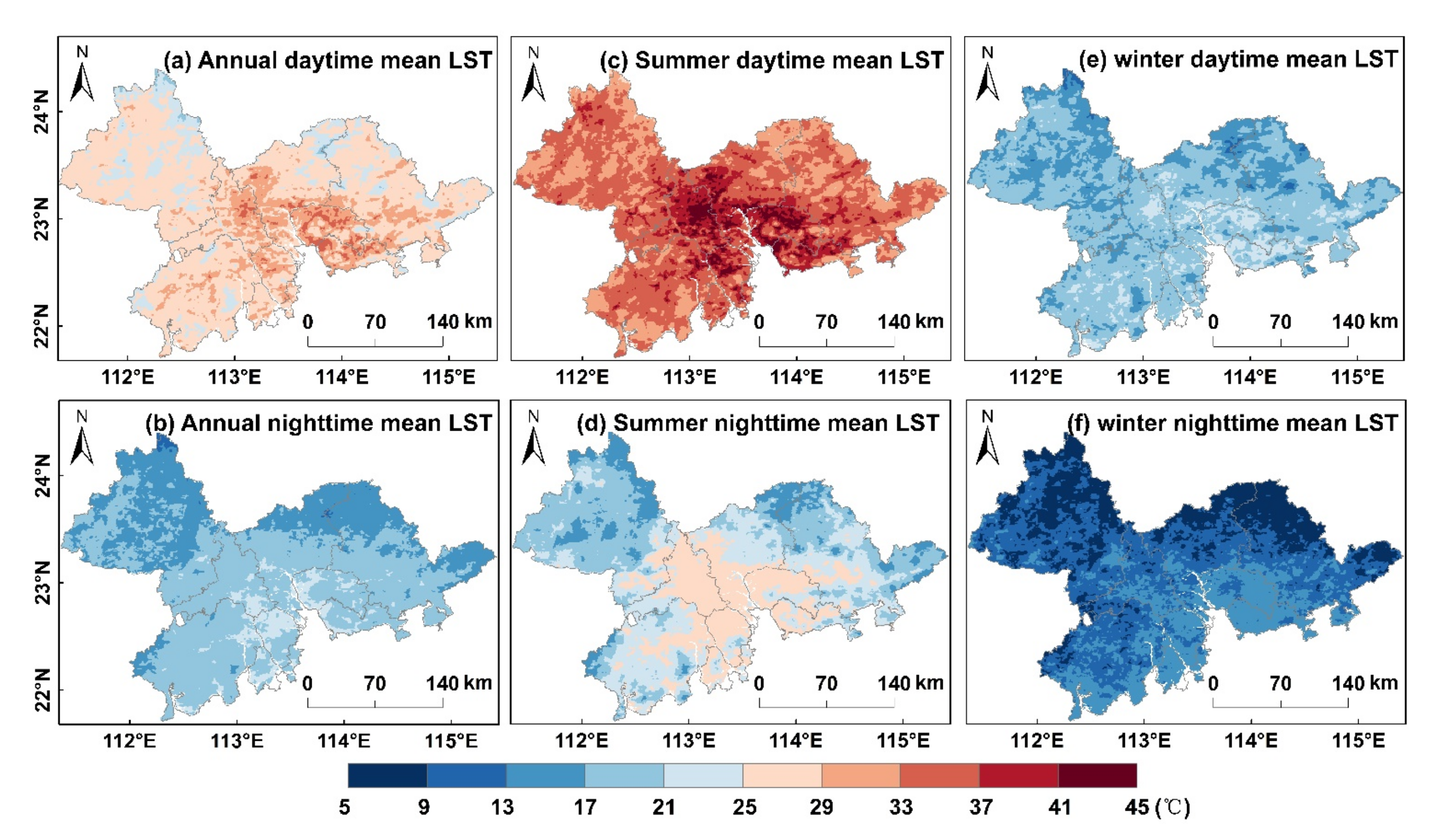
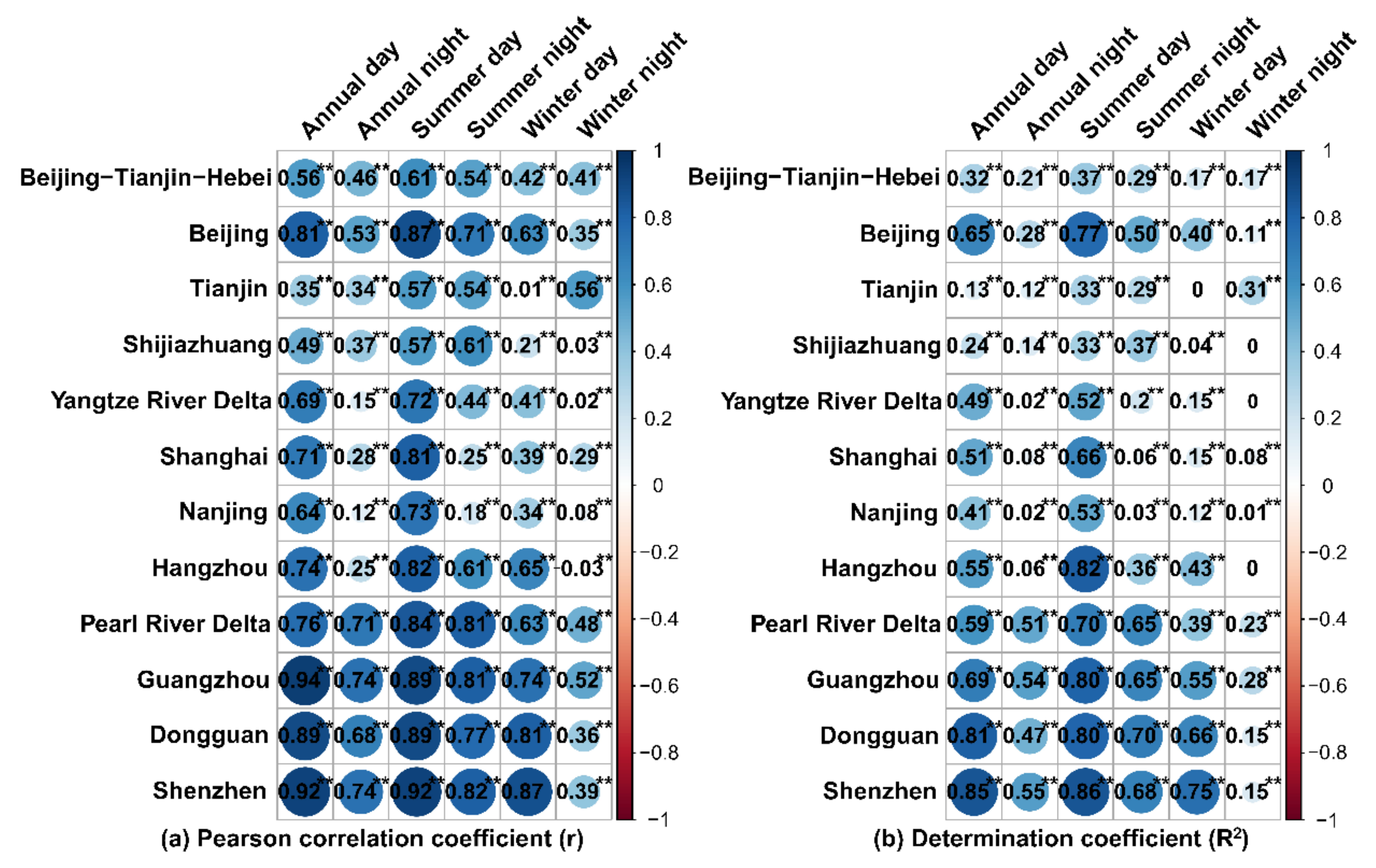

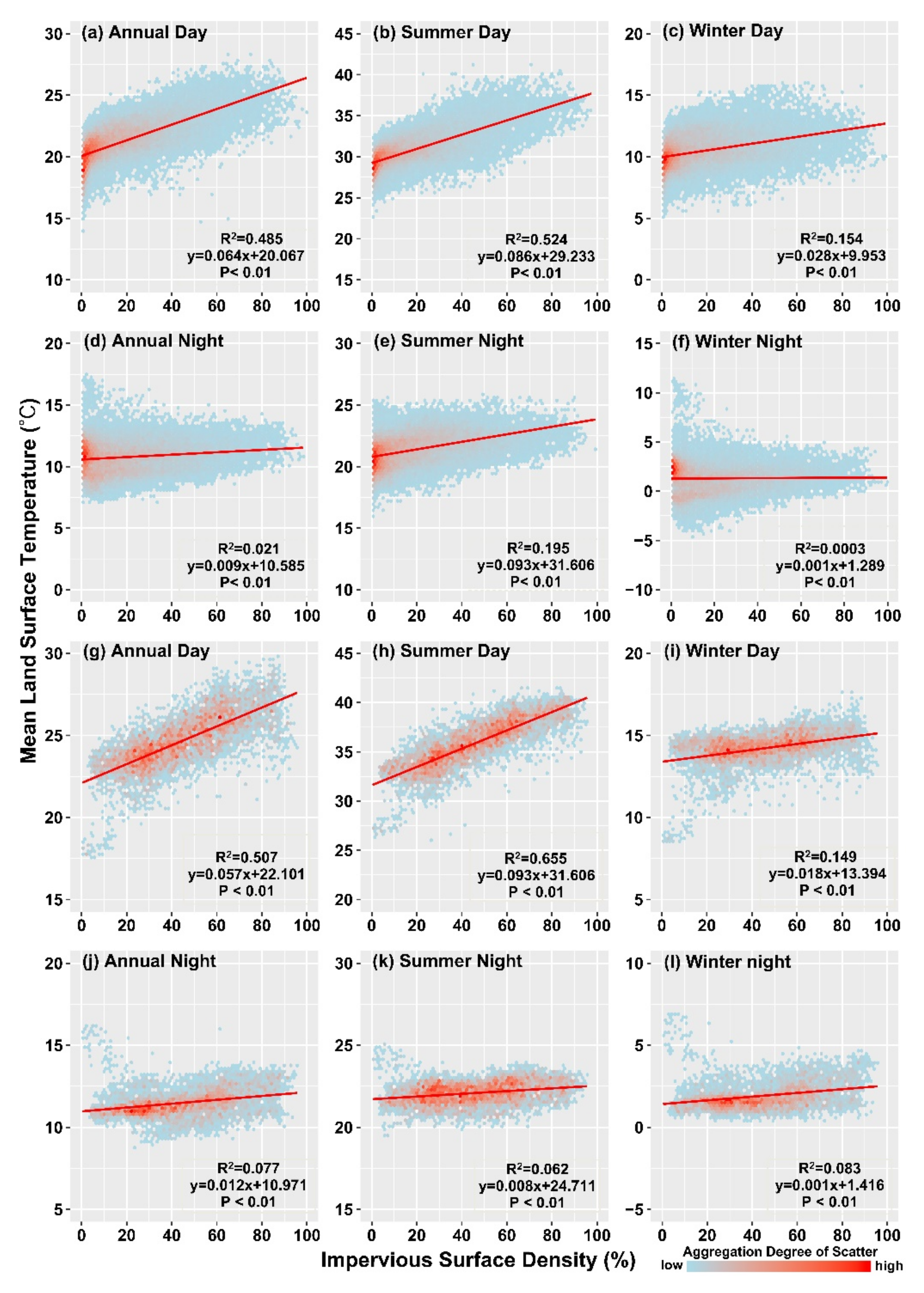
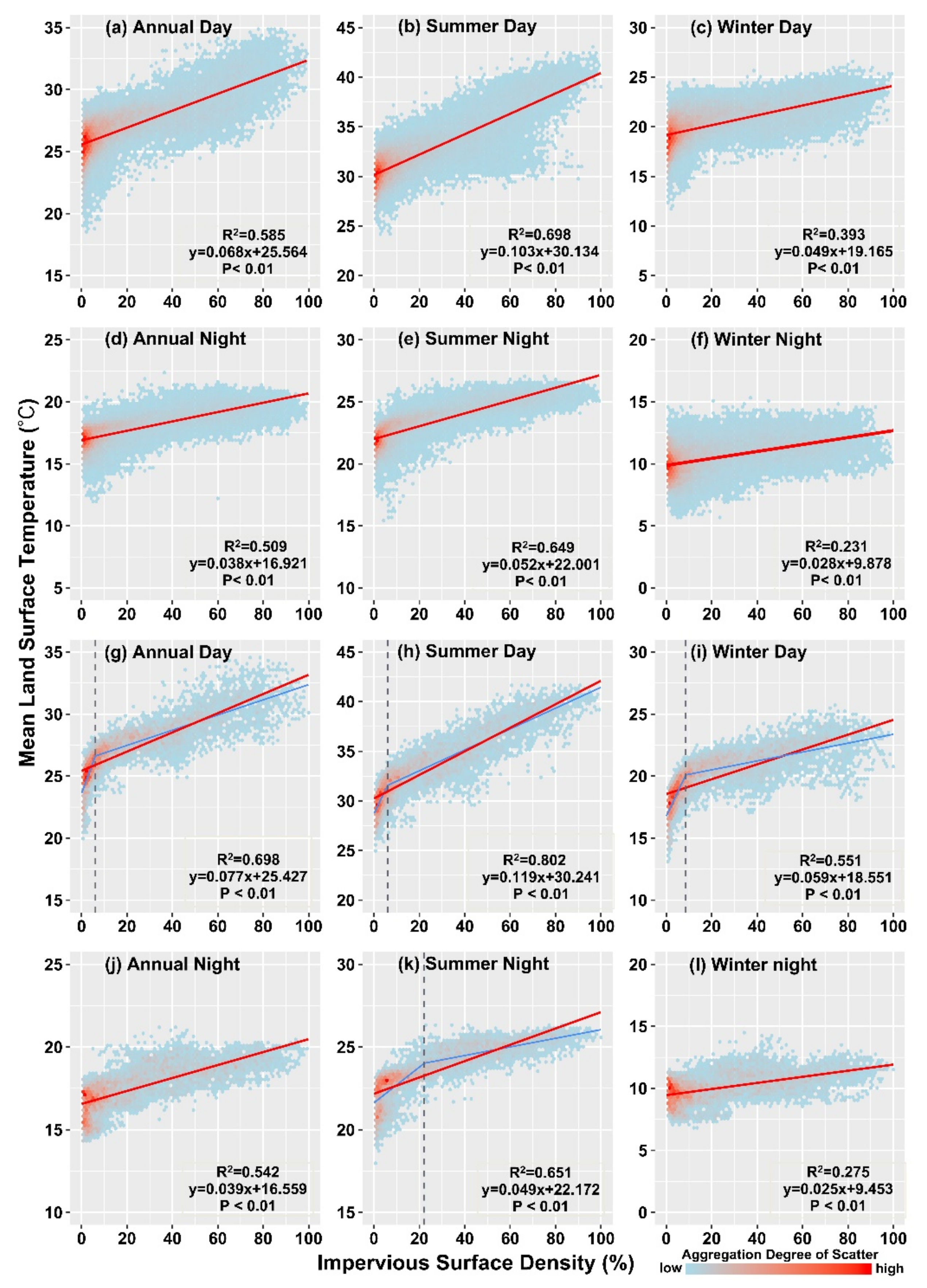
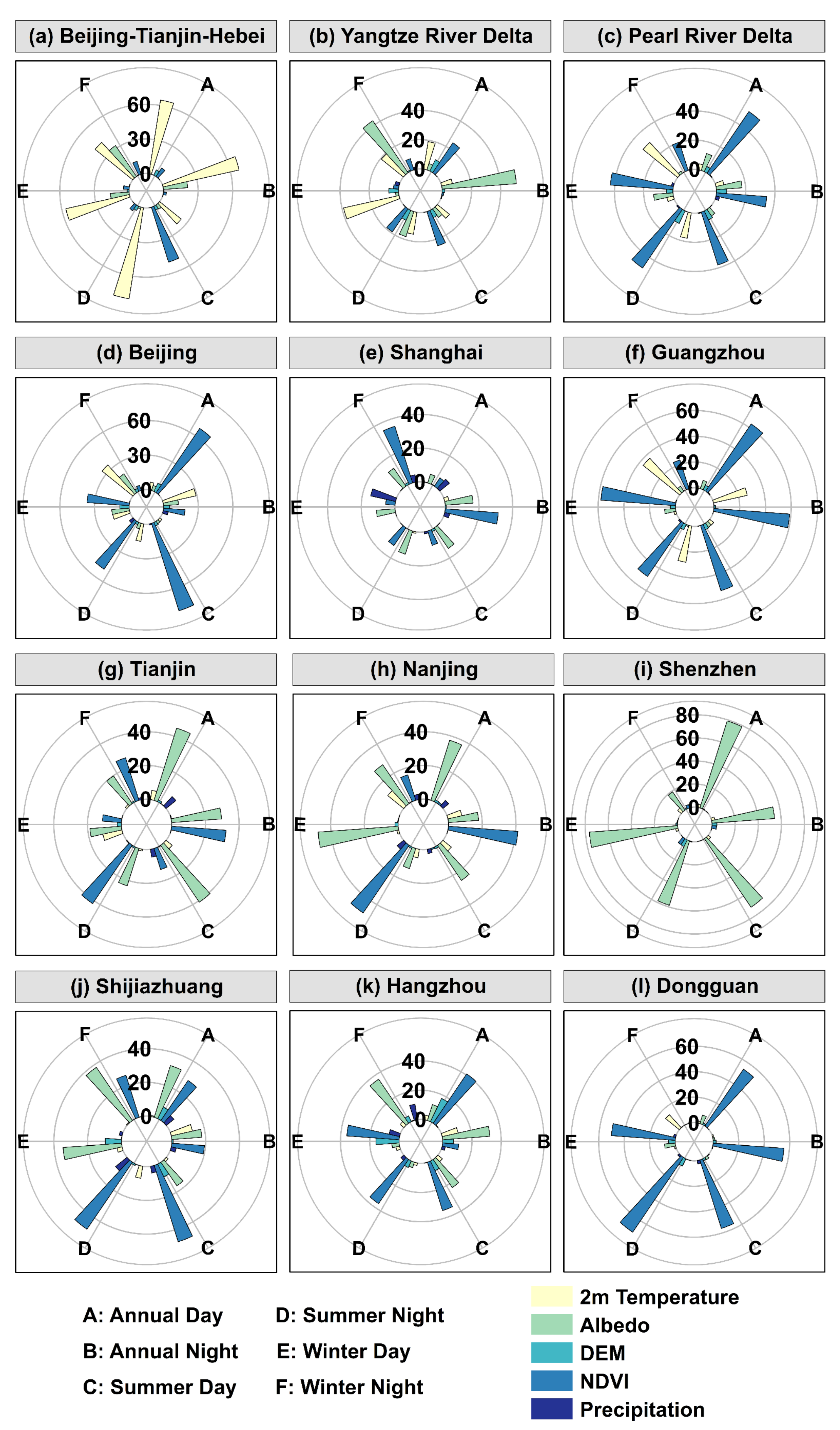
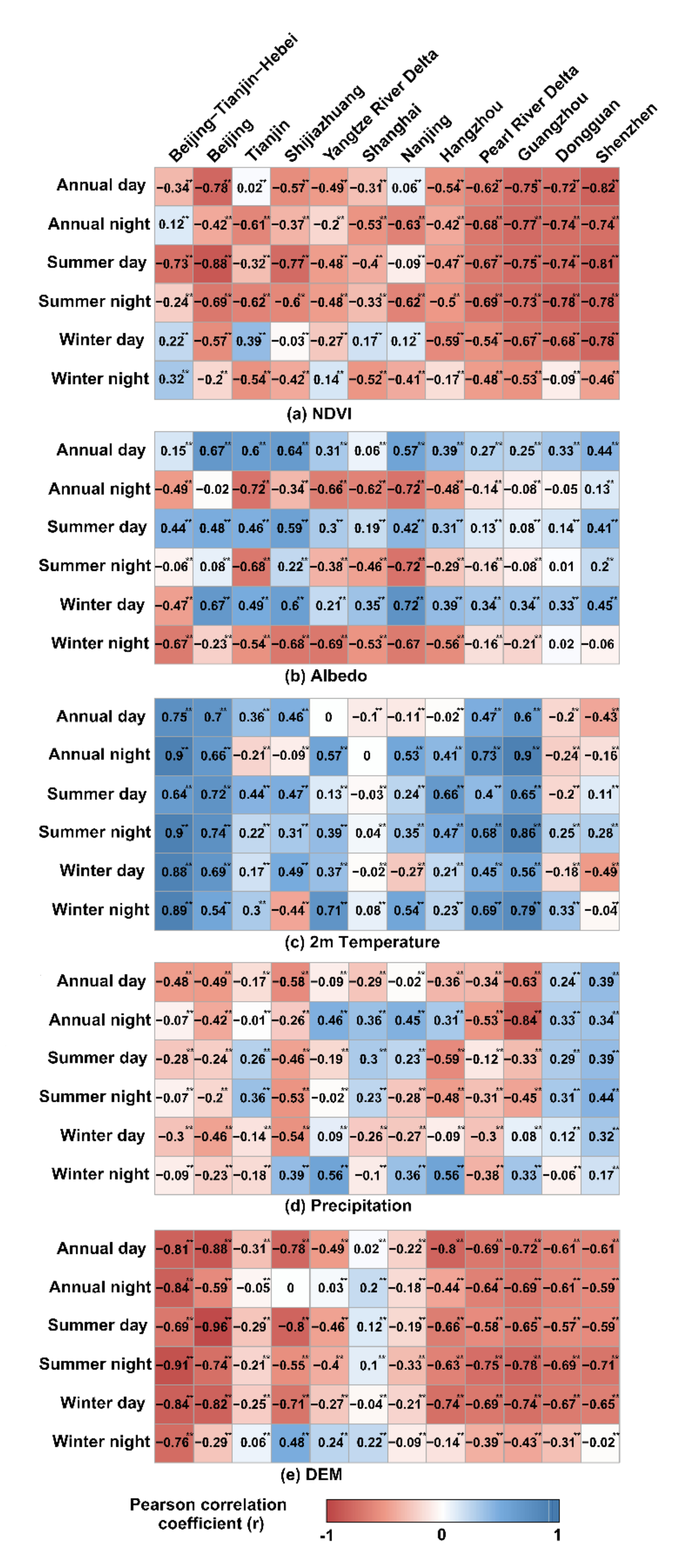
| Urban Agglomerations | Landsat 8 Data Identification | Data Acquisition Time |
|---|---|---|
| Beijing–Tianjin–Hebei | LC81210322015124LGN00 | 2015–05–04 02:40:04 |
| LC81210332015124LGN00 | 2015–05–04 02:40:28 | |
| LC81220332015275LGN00 | 2015–10–02 02:47:29 | |
| LC81230302016221LGN00 | 2016–08–08 02:52:29 | |
| LC81230322015106LGN00 | 2015–04–16 02:52:38 | |
| LC81230342015138LGN00 | 2015–05–18 02:53:04 | |
| LC81240312015257LGN00 | 2015–09–14 02:58:57 | |
| LC81240332015225LGN00 | 2015–08–13 02:59:31 | |
| LC81240352015257LGN00 | 2015–09–14 03:00:33 | |
| LC81250322015216LGN00 | 2015–08–04 03:05:14 | |
| LC81220312015227LGN00 | 2015–08–16 02:46:23 | |
| LC81220322015227LGN01 | 2015–08–16 02:46:47 | |
| LC81220342015275LGN01 | 2015–10–03 02:47:53 | |
| LC81230312016221LGN00 | 2016–08–08 02:52:53 | |
| LC81230332015106LGN01 | 2015–04–17 02:53:02 | |
| LC81230352015138LGN00 | 2015–05–18 02:53:28 | |
| LC81240322015145LGN00 | 2015–05–25 02:58:29 | |
| LC81240342015225LGN01 | 2015–08–14 02:59:55 | |
| LC81250312015120LGN00 | 2015–04–30 03:04:27 | |
| Yangtze River Delta | LC81180382015071LGN01 | 2015–03–13 02:24:21 |
| LC81180402015215LGN00 | 2015–08–03 02:25:09 | |
| LC81190382014299LGN01 | 2014–10–27 02:31:07 | |
| LC81190402015286LGN00 | 2015–10–13 02:31:43 | |
| LC81200372016056LGN01 | 2016–02–26 02:36:36 | |
| LC81200392016088LGN00 | 2016–03–28 02:37:11 | |
| LC81180392015215LGN00 | 2015–08–03 02:24:45 | |
| LC81190372015286LGN01 | 2015–10–14 02:30:32 | |
| LC81190392015286LGN01 | 2015–10–14 02:31:19 | |
| LC81200362015069LGN00 | 2015–03–10 02:35:57 | |
| LC81200382016344LGN01 | 2016–12–10 02:37:24 | |
| LC81200402016088LGN00 | 2016–03–28 02:37:35 | |
| Pearl River Delta | LC81210442015220LGN00 | 2015–08–08 02:45:18 |
| LC81220442015291LGN01 | 2015–10–19 02:51:52 | |
| LC81230432015106LGN00 | 2015–04–16 02:57:17 | |
| LC81230452015106LGN00 | 2015–04–16 02:58:04 | |
| LC81220432015291LGN00 | 2015–10–18 02:51:28 | |
| LC81220452015003LGN00 | 2015–01–03 02:52:17 | |
| LC81230442015106LGN00 | 2015–04–16 02:57:41 |
© 2020 by the authors. Licensee MDPI, Basel, Switzerland. This article is an open access article distributed under the terms and conditions of the Creative Commons Attribution (CC BY) license (http://creativecommons.org/licenses/by/4.0/).
Share and Cite
Zhang, Q.; Wu, Z.; Yu, H.; Zhu, X.; Shen, Z. Variable Urbanization Warming Effects across Metropolitans of China and Relevant Driving Factors. Remote Sens. 2020, 12, 1500. https://doi.org/10.3390/rs12091500
Zhang Q, Wu Z, Yu H, Zhu X, Shen Z. Variable Urbanization Warming Effects across Metropolitans of China and Relevant Driving Factors. Remote Sensing. 2020; 12(9):1500. https://doi.org/10.3390/rs12091500
Chicago/Turabian StyleZhang, Qiang, Zixuan Wu, Huiqian Yu, Xiudi Zhu, and Zexi Shen. 2020. "Variable Urbanization Warming Effects across Metropolitans of China and Relevant Driving Factors" Remote Sensing 12, no. 9: 1500. https://doi.org/10.3390/rs12091500
APA StyleZhang, Q., Wu, Z., Yu, H., Zhu, X., & Shen, Z. (2020). Variable Urbanization Warming Effects across Metropolitans of China and Relevant Driving Factors. Remote Sensing, 12(9), 1500. https://doi.org/10.3390/rs12091500






